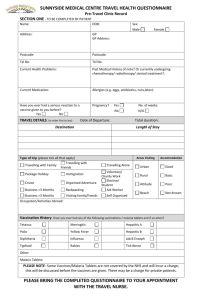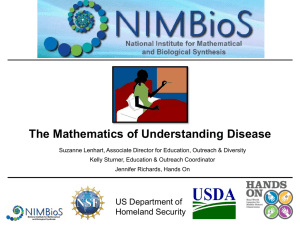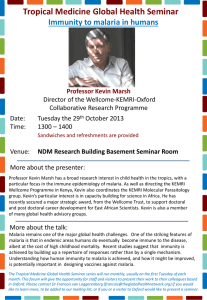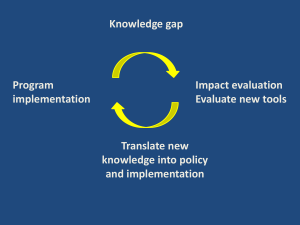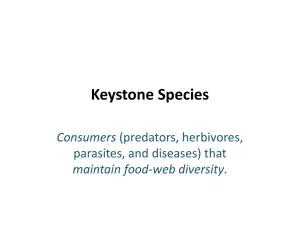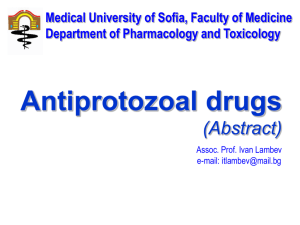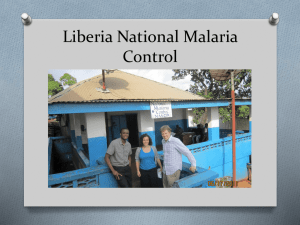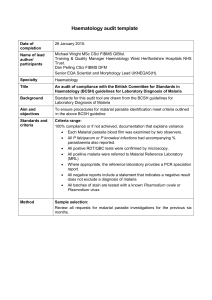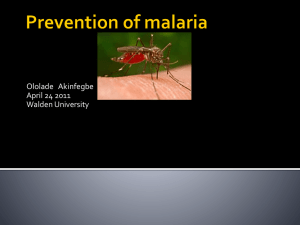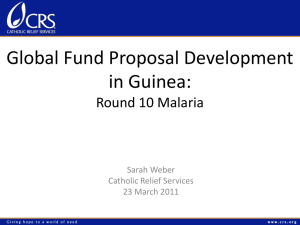Investigating Seasonal Drug Resistance in Malaria
advertisement
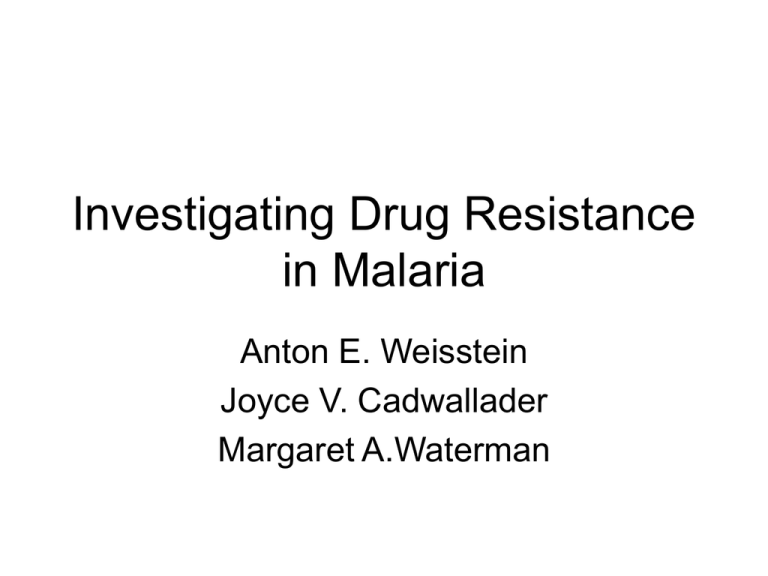
Investigating Drug Resistance in Malaria Anton E. Weisstein Joyce V. Cadwallader Margaret A.Waterman Scientific Roots of this Problem Space • Malaria can be seasonal, with precipitation playing a key role. East Africa has significant wet and dry seasons. • Mosquito populations increase during wet seasons. • Chloroquine was the drug of choice, but resistance developed. Resistance decreased as other drugs were used. • This suggests that resistance carries a cost to fitness of Plasmodium falciparum http://www.mara.org.za/images/picseas.gif https://www.vectorbase.org/sites/default/files/ftp/an_gambiae.png http://www.pharmaceutical-drug-manufacturers.com/gifs/Chloroquine.jpg Background: Common Malaria Drugs Chloroquine (CQ): • The most commonly used to prevent and treat before 1993 • inhibits the conversion of heme (toxic to malaria parasite) to hemozoin thus allowing the toxicity to increase in the cell and lysis to occur releasing sporozoites. • In the late 1970’s resistance was detected. 1993 most countries stop CQ as drug or primary drug Sulfadoxine Pyrimethanime (SP): • A combination of containing sulfonamide antibacterial and the antiparasitic pyrimethanime http://www.traveldoctor.co.uk/images/chloroquine.gif • Both inhibit folic acid synthesis and work synergistically to deprive http://dailymed.nlm.nih.gov/dailymed/archives/image.cfm?archiveid=86578&type=img&name=fa the parasite of this needed nutrient. nsidar-image01.jpg Transdisciplinary Approach to PS Objectives of Problem Space Quantitative and scientific reasoning: • Modeling and simulation. – The model allows students to test hypotheses by designing experiments and manipulating variables to investigate selection under different climate conditions – The frequency changes of the resistant allele (outcome of the model) will then be interpreted by the students from graphic displays of the model simulation. • Critiquing the model in terms of its capabilities and limitations engages students in both the scientific process and reasoning. • Use of data Students will use maps of climate data and incidence of malaria and resistance in their hypothesis formation and interpretation of data, as well as population risk data and bioinformatic data. • Communication literacy: students will use primary literature to find parameters for hypothesis formation and testing with the model. General Introduction to Malaria • One of the scourges of humankind is the disease Malaria. In 2010, the World Health Organization estimated that 216 million people were infected with malaria and 655,000 died. • For understanding the basics of the malaria parasite and disease, go to the Plasmodium Problem Space or CDC Malaria site. Introduction to the Malaria Resistance Curriculum and Problem Space 1. Use Gapminder tool to show global malaria prevalence as affected by poverty. • • Concept of correlation Interpreting graphs, using data 2. Ask students to build a table of data from a CQ resistance map and then create a bubble graph of • malaria cases per 100000—reported versus resistance prevalence http://www.wwarn.org/resistance/explorer Worldwide Antimalarial Resistance Network 3. Provide some data on CQ resistance and loss of it in Malawi. (from Kublin et al., 2003) Year 4. % pfcrt CQ resistance 1992 85 1993-4 50 2000 13 2001 0 Do a Know/Need to Know exercise • • Self awareness of learning Making a learning plan Introduce Modeling Heme 1.1 Excel-based pop. genetics simulation, customized to life cycle of P. falciparum • 75-day rainy season; 290-day dry season • Transmission & treatment only during 1 life stage, only in rainy season • R allele = CQ-resistant, S allele = susceptible (haploid!) • R also has a fitness cost Parameters • Relative fitness costs & benefits of resistance • % of population receiving CQ before and after changes in treatment policy Use published values OR estimate by fitting model to published data Design your own experiment Communication Literacy • Activity – Describe the characteristics of primary literature • Peer review (in a peer reviewed journal) • Own work – Ask students to find an article describing some aspect of malarial resistance • Submit to instructor before class since do not want all to use the same article • Students summarize the article in classroom presentation. • Use some of the data in article to develop a hypothesis for Heme model later. Sample Data Sources • The malaria arena is rich with many forms of data such as: – Data on prevalence, resistance, risk, climate, seasonality as numeric data or maps – Models – Genetic information, i.e., resistant genes sequences that could be used in bioinformatics problems similar to Plasmodium Problem Space Articles Extension: Other Mapping Sites • Use the maps to find out information: – Incidence of malaria in Kenya – Temperature and Precipitation in Kenya – Resistance to Chloroquine in Kenya • Use maps to generate hypotheses and explanations. Data sets • http://www.mara.org.za/popatrisk.htm This is populations at risk. Table exportable to excel Resistance Gene to CQ: Pfcrt 76T • >gi|18542431|gb|AF468006.1| Plasmodium falciparum isolate TM6 putative chloroquine resistance transporter mRNA, complete • cdsATGAAATTCGCAAGTAAAAAAAATAATCAAAAAAATTCAAGCAAAAATGACGAGCGTTATAG AGAATTAGATAATTTAGTACAAGAAGGAAATGGCTCACGTTTAGGTGGAGGTTCTTGTCTTGGT AAATGTGCTCATGTGTTTAAACTTATTTTTAAAGAGATTAAGGATAATATTTTTATTTATATTTTAAG TATTATTTATTTAAGTGTATGTGTAATTGAAACAATTTTTGCTAAAAGAACTTTAAACAAAATTGGT AACTATAGTTTTGTAACATCCGAAACTCACAACTTTATTTGTATGATTATGTTCTTTATTGTTTATT CCTTATTTGGAAATAAAAAGGGAAATTCAAAAGAACGACGCCGAAGCTTTAATTTACAATTTTTT GCTATATCCATGTTAGATGCCTGTTCAGTCATTTTGGCCTTCATAGGTCTTACAAGAACTACTG GAAATATCCAATCATTTGTTCTTCAATTAAGTATTCCTATTAATATGTTCTTCTGCTTTTTAATATTA AGATATAGATATCACTTATACAATTATCTCGGAGCAGTTATTATTGTTGTAACAATAGCTCTTGTA GAAATGAAATTATCTTTTGAAGCACAAGAAGAAAATTCTATCATATTTAATCTTGTCTTAATTAGT TCCTTAATTCCTGTATGCTTTTCAAACATGACAAGGGAAATAGTTTTTAAAAAATATAAGATTGAC ATTTTAAGATTAAATGCTATGGTATCCTTTTTCCAATTGTTCACTTCTTGTCTTATATTACCTGTAT ACACCCTTCCATTTTTAAAAGAACTTCATTTACCATATAATGAAATATGGACAAATATAAAAAATG GTTTCGCATGTTTATTCTTGGGAAGAAACACAGTCGTAGAGAATTGTGGTCTTGGTATGGCTAA GTTATGTGATGATTGTGACGGAGCATGGAAAACCTTCGCATTGTTTTCCTTCTTTAGCATTTGT GATAATTTAATAACCAGCTATATTATCGACAAATTTTCTACCATGACATATACTATTGTTAGTTGTA TACAAGGTCCAGCAATAGCAATTGCTTATTACTTTAAATTCTTAGCCGGTGATGTTGTAATAGAA CCAAGATTATTAGATTTCGTAACTTTGTTTGGCTACCTATTTGGTTCTATAATTTACCGTGTAGGA AATATTATCTTAGAAAGAAAAAAAATGAGAAATGAAGAAAATGAAGATTCCGAAGGAGAATTAA CCAACGTCGATTCAATTATTACACAATAA You Know What To Do!!!!! Bibliography (partial) Bibliography of map resources
